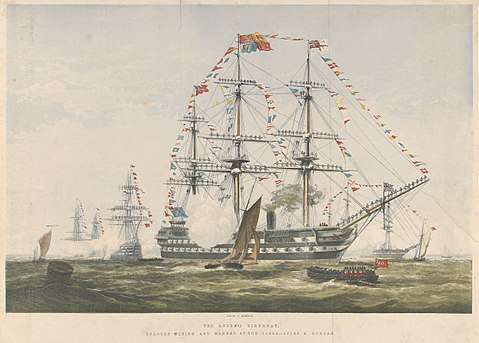HMS James Watt
HMS James Watt was a 91-gun steam and sail-powered second rate ship of the line. She had originally been ordered as one of a two ship class, with her sister HMS Cressy, under the name HMS Audacious. She was renamed on 18 November 1847 in honour of James Watt, the purported inventor of the steam engine. (The steam engine was actually invented by Thomas Newcomen.) She was the only Royal Navy ship to bear this name. Both ships were reordered as screw propelled ships, James Watt in 1849, and Cressy in 1852. James Watt became one of the four-ship Agamemnon-class of ships of the line. They were initially planned as 80-gun ships, but the first two ships built to the design, HMS Agamemnon and James Watt, were rerated on 26 March 1851 to 91 guns ships, later followed by the remainder of the class.
 HMS James Watt | |
| History | |
|---|---|
| Name: | HMS James Watt |
| Ordered: |
|
| Builder: |
|
| Laid down: | September 1850 |
| Launched: | 23 April 1853 |
| Completed: | By 27 March 1854 |
| Renamed: | Ordered as HMS Audacious, renamed on 18 November 1847 |
| Fate: | Sold to Castle for breaking up at Charlton in January 1875 |
| General characteristics as planned | |
| Class and type: | 84-gun Cressy-class second rate ship of the line |
| Tons burthen: | 2,537 80/94 bm |
| Length: |
|
| Beam: | 55 ft (16.8 m) |
| Depth of hold: | 21 ft 8.25 in (6.6 m) |
| Propulsion: | Sails |
| Complement: | 750 |
| Armament: |
|
| General characteristics as launched | |
| Class and type: | 91-gun Agamemnon-class second rate ship of the line |
| Tons burthen: | 3,074 45/94 bm |
| Length: |
|
| Beam: | 55 ft 4 in (16.9 m) |
| Depth of hold: | 24 ft 6 in (7.5 m) |
| Propulsion: |
|
| Complement: | 860 |
| Armament: |
|
The ship had an overall length of 265 feet 3 inches, length between perpendiculars of 230 feet, and beam of 55 feet 5 inches. Her displacement was 3083 tons and her screw was driven by a 600 hp engine.[1] She was built at the Royal Dockyard, Pembroke Dock, launched on 23 April 1853 and commissioned at Plymouth in January 1854 by Captain George Elliot. She served in the Baltic campaigns of 1854 and 1855, despite the poor performance of the ship, and the dissatisfaction of Vice-Admiral Charles Napier. Her machinery, taken second hand from the iron frigate HMS Vulcan, was found to be unsatisfactory. By 1856 alterations to the machinery had cost £5,706, and from 1856 to 1857 she was commanded by Captain Talavera Anson. She was sold for breaking up to Castle, of Charlton in January 1875.[2]
Notes
- David James, Down the Slipway! Ships of Pembrokeshire's Secret Waterway (Milford Haven: Peter Williams Associates, 2006 OCLC 153552570), p. 65.
- David James, Down the Slipway! Ships of Pembrokeshire's Secret Waterway p. 156.
References
- Colledge, J. J.; Warlow, Ben (2006) [1969]. Ships of the Royal Navy: The Complete Record of all Fighting Ships of the Royal Navy (Rev. ed.). London: Chatham Publishing. ISBN 978-1-86176-281-8.
- Winfield, R.; Lyon, D. (2004). The Sail and Steam Navy List: All the Ships of the Royal Navy 1815–1889. London: Chatham Publishing. ISBN 978-1-86176-032-6.
